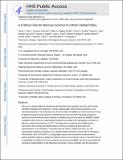| dc.contributor.author | Chen, Celia Y. | |
| dc.contributor.author | Driscoll, Charles T. | |
| dc.contributor.author | Eagles-Smith, Collin A. | |
| dc.contributor.author | Eckley, Chris S. | |
| dc.contributor.author | Gay, David A. | |
| dc.contributor.author | Hsu-Kim, Heileen | |
| dc.contributor.author | Keane, Susan E. | |
| dc.contributor.author | Kirk, Jane L. | |
| dc.contributor.author | Mason, Robert P. | |
| dc.contributor.author | Obrist, Daniel | |
| dc.contributor.author | Selin, Henrik | |
| dc.contributor.author | Selin, Noelle E | |
| dc.contributor.author | Thompson, Marcella R. | |
| dc.date.accessioned | 2020-01-21T18:36:10Z | |
| dc.date.available | 2020-01-21T18:36:10Z | |
| dc.date.issued | 2018-09 | |
| dc.identifier.issn | 0013-936X | |
| dc.identifier.issn | 1520-5851 | |
| dc.identifier.uri | https://hdl.handle.net/1721.1/123488 | |
| dc.description.abstract | Mercury is a global pollutant released into the biosphere by varied human activities including coal combustion, mining, artisanal gold mining, cement production, and chemical production. Once released to air, land and water, the addition of carbon atoms to mercury by bacteria results in the production of methylmercury, the toxic form that bioaccumulates in aquatic and terrestrial food chains resulting in elevated exposure to humans and wildlife. Global recognition of the mercury contamination problem has resulted in the Minamata Convention on Mercury, which came into force in 2017. The treaty aims to protect human health and the environment from human-generated releases of mercury curtailing its movement and transformations in the biosphere. Coincident with the treaty's coming into force, the 13th International Conference of Mercury as a Global Pollutant (ICMGP-13) was held in Providence, Rhode Island USA. At ICMGP-13, cutting edge research was summarized and presented to address questions relating to global and regional sources and cycling of mercury, how that mercury is methylated, the effects of mercury exposure on humans and wildlife, and the science needed for successful implementation of the Minamata Convention. Human activities have the potential to enhance mercury methylation by remobilizing previously released mercury, and increasing methylation efficiency. This synthesis concluded that many of the most important factors influencing the fate and effects of mercury and its more toxic form, methylmercury, stem from environmental changes that are much broader in scope than mercury releases alone. Alterations of mercury cycling, methylmercury bioavailability and trophic transfer due to climate and land use changes remain critical uncertainties in effective implementation of the Minamata Convention. In the face of these uncertainties, important policy and management actions are needed over the short-term to support the control of mercury releases to land, water and air. These include adequate monitoring and communication on risk from exposure to various forms of inorganic mercury as well as methylmercury from fish and rice consumption. Successful management of global and local mercury pollution will require integration of mercury research and policy in a changing world. | en_US |
| dc.language.iso | en | |
| dc.publisher | American Chemical Society (ACS) | en_US |
| dc.relation.isversionof | http://dx.doi.org/10.1021/acs.est.8b02286 | en_US |
| dc.rights | Article is made available in accordance with the publisher's policy and may be subject to US copyright law. Please refer to the publisher's site for terms of use. | en_US |
| dc.source | PMC | en_US |
| dc.title | A Critical Time for Mercury Science to Inform Global Policy | en_US |
| dc.type | Article | en_US |
| dc.identifier.citation | Chen, Celia Y. et al. "A Critical Time for Mercury Science to Inform Global Policy." Environmental Science & Technology 52, 17 (September 2018): 9556-9561 © 2018 American Chemical Society | en_US |
| dc.contributor.department | Massachusetts Institute of Technology. Department of Earth, Atmospheric, and Planetary Sciences | en_US |
| dc.relation.journal | Environmental Science & Technology | en_US |
| dc.eprint.version | Author's final manuscript | en_US |
| dc.type.uri | http://purl.org/eprint/type/JournalArticle | en_US |
| eprint.status | http://purl.org/eprint/status/PeerReviewed | en_US |
| dc.date.updated | 2019-11-06T18:44:02Z | |
| dspace.date.submission | 2019-11-06T18:44:06Z | |
| mit.journal.volume | 52 | en_US |
| mit.journal.issue | 17 | en_US |
| mit.metadata.status | Complete | |
